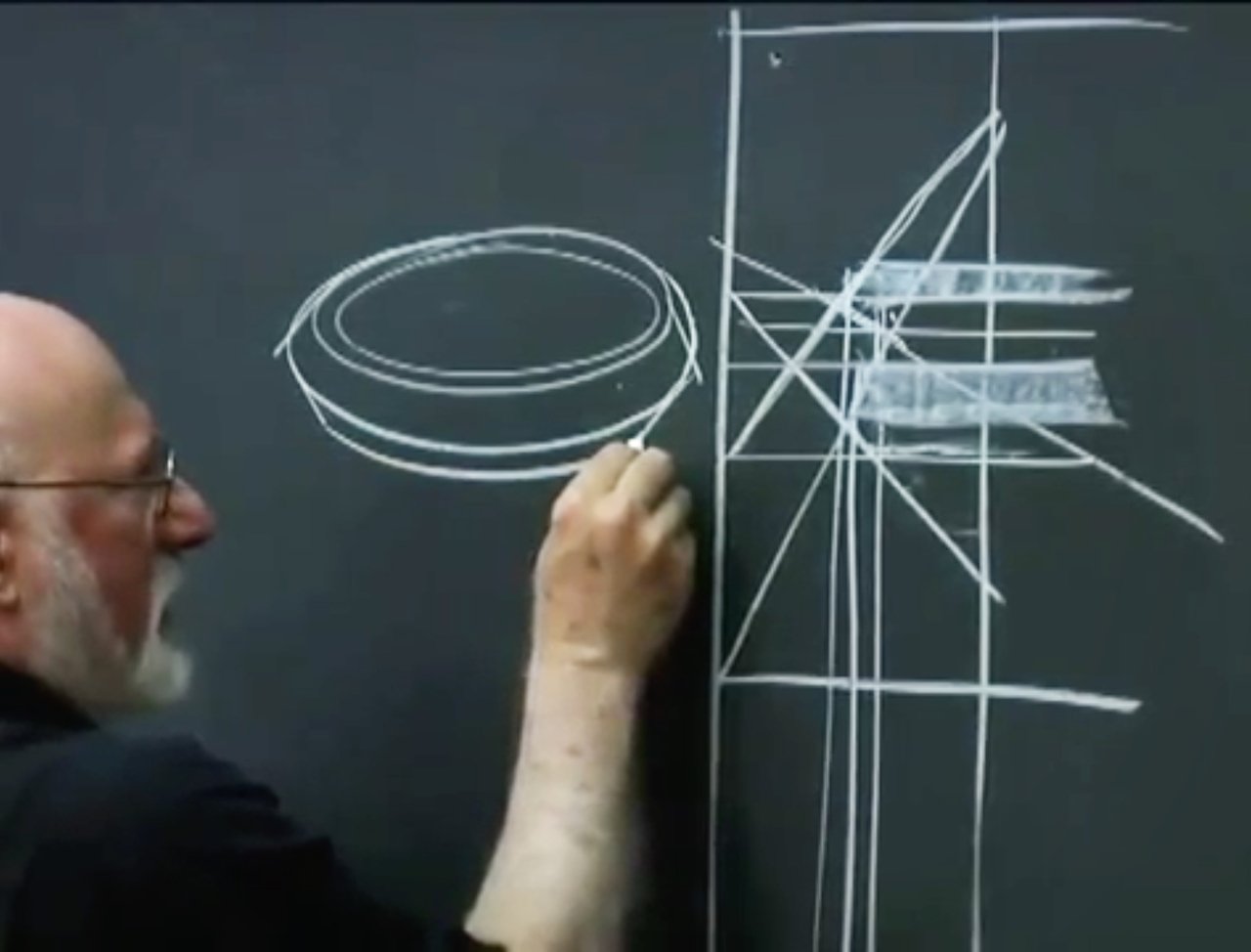About Introduction to Drawing Systems Download
Barnstone Design Method on Video
To further enhance your learning experience, purchase the accompanying workbook: Introduction to Drawing & Design
Download Course Cheat Sheets on our Resources Page
Whatever your goals may be, the content in this course will help you achieve them. The methods and principles taught convey essential, underlying techniques that are not readily available in most art education programs or classes today, making this course an invaluable resource for designers, experienced or aspiring artists and arts educators.
In the Introduction to Drawing Systems course, the student begins with a family of three bottles, learning how to assess the particular proportions and shape characteristics of their subjects. Like observing the proportional differences between people, the careful examination of bottles reveals a subtle anatomy of simple geometric shapes that creates the unity and variety for a harmonic structure, animating the entire composition. Delving much deeper in the complexities of form, students will learn to organize the three-dimensional volumes and surfaces, illuminate and render form in light and shadow, and organize their subject using the ancient geometric principles of the Golden Section.
The Barnstone Digital packages follow the curriculum developed by Myron Barnstone to teach Drawing & Design. Mr. Barnstone’s Methods have proven to be successful over the past 30+ years in the amount of scholarship money awarded to students as well as the successful careers of a number of professional Artists, Architects, Educators & Designers.
Anyone wishing to purchase and study from the video sets is strongly encouraged to start with Drawing Lesson 1 and proceed through the material in order. Mr. Barnstone builds upon each previous lesson. The Figure Drawing and Color Videos would be best studied after all the Drawing material. Included are projects to reinforce all concepts and best practices with a critique of the assignments in the following videos.
Drawing Videos: The most comprehensive drawing & design course available anywhere. Take your time and repeat and review as necessary.
Lesson 1: Introduction and Analysis of Bottle Design
Introduction to the basic principles and fundamental terms and ideas that are key to the Barnstone Method; observational measurement to assess proportions; construct a notional space; sight directions and coincidental relationships; apply triangulation; gesture drawing and analytical drawing procedures
Lesson 2: The Two Dimensional Bottle
Deconstruct complex forms into simple basic shapes; figure-to-ground relationships; rhythmic structures using linear parallels, radiating lines, enclosures, and arabesque; use of passage and vignette; aerial perspective; gazing direction; enclosures; vignette; negative spaces; gamut; how to identify visual errors
Lesson 3: The Sphere and the Cube
Conceive and describe the surface contours and cross contours of a sphere; construct the circle template and divisions within the sphere; tessellation, cross-sections, and dimensional truncations; invent complex interior 3D geometries
Lesson 4: The Three Dimensional Bottle Projection
Build complex 3D forms from basic volumes; construct analytical 3D volumes for 2D shapes; create concentric ellipses of various diameters in a plane; compose volumetric objects in a pictorial field with an implied 3D space
Lesson 5: The Sphere in Value
Understand and apply highlight, light, shadow, shadow core, reflected light, cast shadow, light and dark halos; rendering techniques; relate the light direction to the 3D surface volume of a sphere; apply passage and vignette; emphasize versus flatten surface volumes using light and value
Lesson 6: The Bottles in Value
Apply directional lighting to the surfaces of 3D volumes; differentiate cast shadow and form shadow; apply aerial perspective, zoning, and pictorial emphasis; Rembrandt lighting; value rendering
Lesson 7: The Golden Section and Root Rectangles
Distinguish and Construct golden section and root rectangle geometry; the armature of a rectangle, diagonals, crossing lines; the gamut; composition; deconstruct geometry into proportional armatures; establish spatial hierarchies; compose imagery into the geometry of a rectangle
Lesson 8: The Plant
Plan and compose a complex design subject; design visual pathways and gamut; arrange relative positions and overlaps; foreshortening; organize 3D arabesques; apply rhythmic structures to create coincidences and harmonize diverse parts of a design
Lesson 9: The Portrait - Geometry of the Head
Recognize and apply proportional geometry to the canon of the face and head; how and why to break down curvilinear into straight line information; formalization and stylization; create expressive distortions by manipulating the proportional relationships of a face to a grid
Lesson 10: An Overview of the System of Dynamic Symmetry
Comprehend and construct the following: Rebated Squares and Saint Andrew’s Cross; Root 2 rectangle, √2 (1:1.414…) - Theme of 2 and 3; Root 3 Rectangle, √3 (1:1.732…); Root 4 Rectangle (double square), √4 (1:2); Root 5 Rectangle, √5 (1:2.236…); Golden Section Rectangle (Phi), ϕ (1:1.618…); 1.5 Rectangle (1:1.5); Root Phi Rectangle, √ϕ (1:1.272…); Apply a rectangle gauge to analyze/re-discover the geometric construction built into a master artwork
Buy 10 or above and get 25% off

Kathleen Swope –
I am an art teacher. I use the course not only for my professional development but also will be purchasing some of the recommended texts for our school library. My hope is to create interdisciplinary art/ math projects.
Craig Barrack –
I loved everything I watched.
Myron is fantastic!
Sean Delonas –
Very briefly studied at Barnstone Studios in the early 1980’s. Myron was the first art teacher I had who actually taught art in a serious manner. I’ve worked as a professional illustrator/fine artist ( http://www.SeanDelonas.com ) for the past 30 years and still use what I learned from drawing those bottles. Thank you, Myron Barnstone.
Theresa Britton –
The [videos] introduced me to old and new theories, and concepts. The courses allowed me to fill in the blanks that were missing from my education. If you apply the work and time your drawing skills will improve. The [videos] are easy to understand. I only wish there was feedback in the courses. Thank you for the knowledge and time spent on these videos.